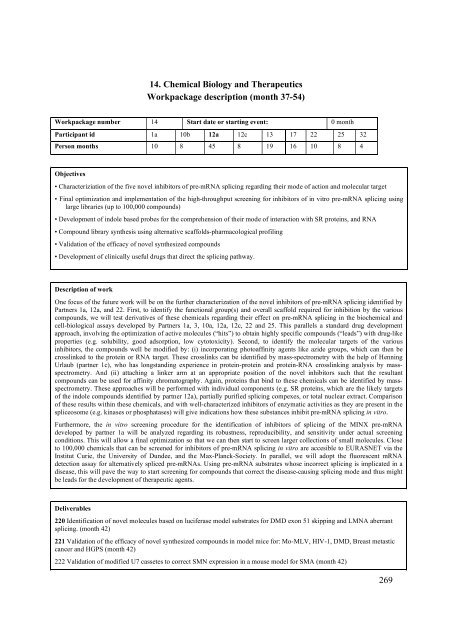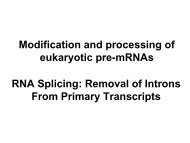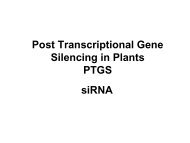You also want an ePaper? Increase the reach of your titles
YUMPU automatically turns print PDFs into web optimized ePapers that Google loves.
14. Chemical Biology and TherapeuticsWorkpackage description (month 37-54)Workpackage number 14 Start date or starting event: 0 monthParticipant id 1a 10b 12a 12c 13 17 22 25 32Person months 10 8 45 8 19 16 10 8 4Objectives• Characteriziation of the five novel inhibitors of pre-mRNA splicing regarding their mode of action and molecular target• Final optimization and implementation of the high-throughput screening for inhibitors of in vitro pre-mRNA splicing usinglarge libraries (up to 100,000 compounds)• Development of indole based probes for the comprehension of their mode of interaction with SR proteins, and RNA• Compound library synthesis using alternative scaffolds-pharmacological profiling• Validation of the efficacy of novel synthesized compounds• Development of clinically useful drugs that direct the splicing pathway.Description of workOne focus of the future work will be on the further characterization of the novel inhibitors of pre-mRNA splicing identified byPartners 1a, 12a, and 22. First, to identify the functional group(s) and overall scaffold required for inhibition by the variouscompounds, we will test derivatives of these chemicals regarding their effect on pre-mRNA splicing in the biochemical andcell-biological assays developed by Partners 1a, 3, 10a, 12a, 12c, 22 and 25. This parallels a standard drug developmentapproach, involving the optimization of active molecules (“hits”) to obtain highly specific compounds (“leads”) with drug-likeproperties (e.g. solubility, good adsorption, low cytotoxicity). Second, to identify the molecular targets of the variousinhibitors, the compounds well be modified by: (i) incorporating photoaffinity agents like azide groups, which can then becrosslinked to the protein or RNA target. These crosslinks can be identified by mass-spectrometry with the help of HenningUrlaub (partner 1c), who has longstanding experience in protein-protein and protein-RNA crosslinking analysis by massspectrometry.And (ii) attaching a linker arm at an appropriate position of the novel inhibitors such that the resultantcompounds can be used for affinity chromatography. Again, proteins that bind to these chemicals can be identified by massspectrometry.These approaches will be performed with individual components (e.g. SR proteins, which are the likely targetsof the indole compounds identified by partner 12a), partially purified splicing compexes, or total nuclear extract. Comparisonof these results within these chemicals, and with well-characterized inhibitors of enzymatic activities as they are present in thespliceosome (e.g. kinases or phosphatases) will give indications how these substances inhibit pre-mRNA splicing in vitro.Furthermore, the in vitro screening procedure for the identification of inhibitors of splicing of the MINX pre-mRNAdeveloped by partner 1a will be analyzed regarding its robustness, reproducibility, and sensitivity under actual screeningconditions. This will allow a final optimization so that we can then start to screen larger collections of small molecules. Closeto 100,000 chemicals that can be screened for inhibitors of pre-mRNA splicing in vitro are accesible to <strong>EURASNET</strong> via theInstitut Curie, the University of Dundee, and the Max-Planck-Society. In parallel, we will adopt the fluorescent mRNAdetection assay for alternatively spliced pre-mRNAs. Using pre-mRNA substrates whose incorrect splicing is implicated in adisease, this will pave the way to start screening for compounds that correct the disease-causing splicing mode and thus mightbe leads for the development of therapeutic agents.Deliverables220 Identification of novel molecules based on luciferase model substrates for DMD exon 51 skipping and LMNA aberrantsplicing. (month 42)221 Validation of the efficacy of novel synthesized compounds in model mice for: Mo-MLV, HIV-1, DMD, Breast metasticcancer and HGPS (month 42)222 Validation of modified U7 cassetes to correct SMN expression in a mouse model for SMA (month 42)269







